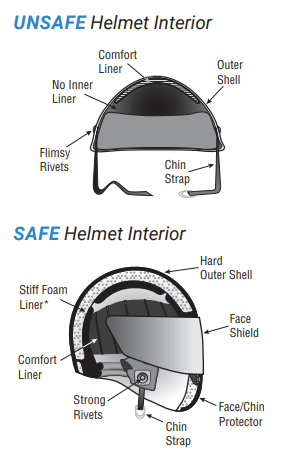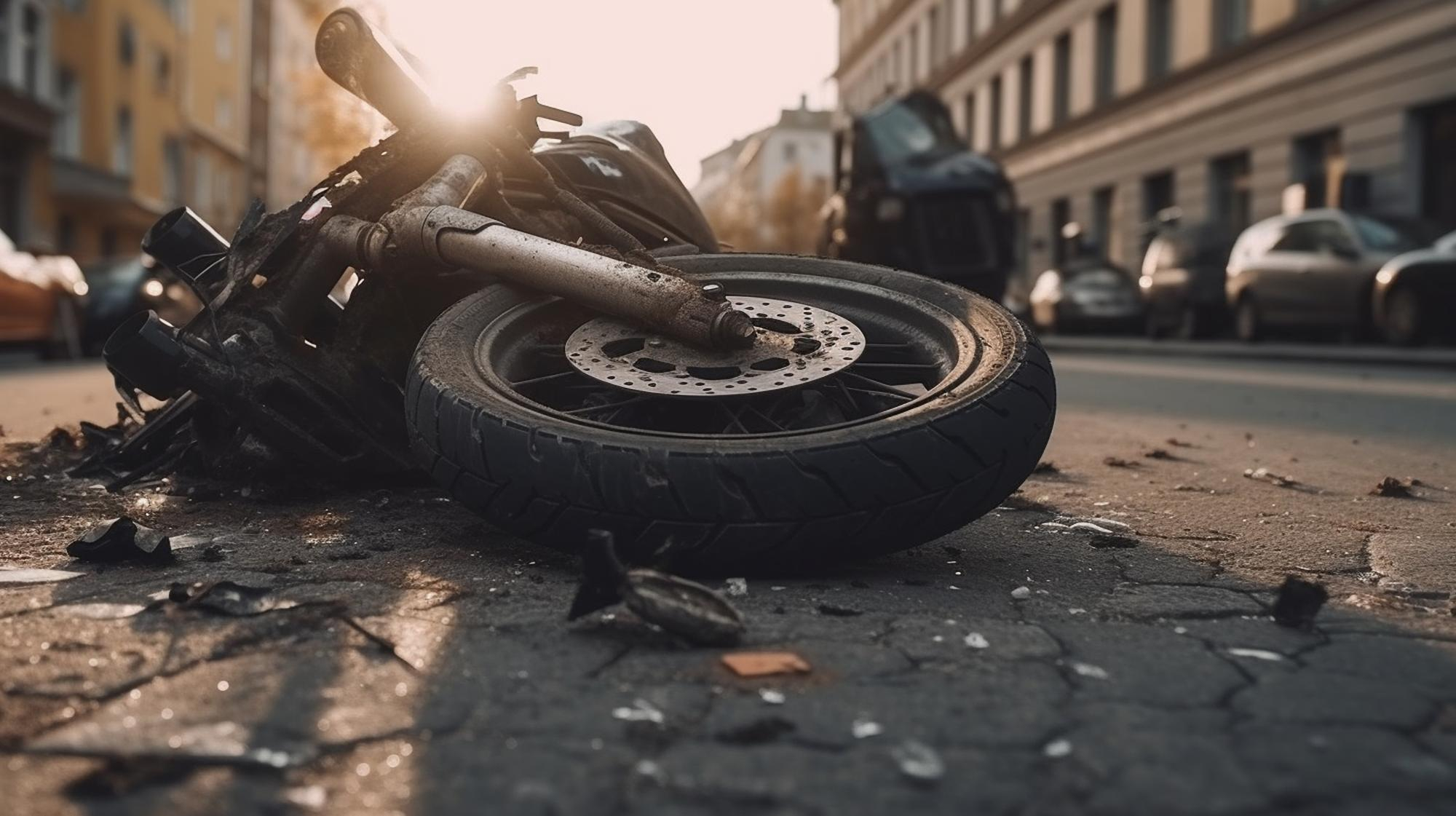Motorcycle helmet laws in California are among the strictest in the United States. According to California Vehicle Code (CVC) §27803, all riders and passengers are mandated to wear a U.S. DOT compliant motorcycle safety helmet when operating or riding a motorcycle, motor-driven cycle, or motorized bicycle. These helmets must meet the U.S. Department of Transportation’s Federal Motor Vehicle Safety Standard (FMVSS) 218 to ensure they provide adequate protection against head injuries, which are a leading cause of severe and fatal injuries in motorcycle accidents.
California’s strict mandatory helmet laws reflect the state’s commitment to reducing motorcycle fatalities and injuries. Despite motorcycles being less common on the roads compared to cars, motorcycle accidents often result in more serious injuries. Wearing a properly fitted, DOT-compliant helmet significantly reduces the risk of catastrophic or fatal injuries in the event of a crash. Understanding and adhering to these laws helps riders avoid fines and plays a crucial role in protecting their lives and well-being while riding on California roads.
If you have been injured, call us today at (866) 936 7349 to schedule a free consultation
What Are California Motorcycle Helmet Laws?
California’s motorcycle helmet laws, as outlined in Vehicle Code Section 27803, mandate that both operators and passengers of motorcycles, motor-driven cycles, and motorized bicycles must wear a safety helmet. This requirement is comprehensive and extends beyond traditional motorcycles to include all motorized bicycles and motor-driven cycles. The law ensures that safety helmets meeting U.S. DOT Federal Motor Vehicle Safety Standard are worn at all times to protect riders from suffering catastrophic or fatal injuries while on the road.
Specifically, California Vehicle Code 27803(a) stipulates that drivers and passengers must wear helmets that meets the requirements established pursuant to Section 27802. It is unlawful to operate or ride as a passenger on these vehicles without a properly secured helmet. This regulation applies to vehicles operated on highways and aims to reduce the risk of severe head injuries in the event of an accident.
Why Was California’s Motorcycle Helmet Law Implemented?
California’s motorcycle helmet law was implemented in 1992 in response to data that indicated that of the 3,000 annual motorcycle deaths that occurred in 1990 [1], roughly 55% were not wearing a helmet. These studies highlighted that a portion of these deaths and the severity of the serious injuries could have been reduced with the use of proper motorcycle helmets.
The law was enacted to protect motorcyclists and their passengers and aimed to mitigate the devastating physical, emotional, and financial impacts of motorcycle accidents. Beyond saving lives, the helmet law sought to alleviate the financial strain on families, insurance companies, and state agencies. By reducing the incidence of severe injuries, the law helps to lower healthcare costs, decrease insurance claims, and minimize the economic burden on the state’s healthcare system.
Did Implementing California Helmet Laws Work?
While the safety impacts of implementing motorcycle helmet laws in California were hard to validate due to the size of the state and data collection methods, studies conducted by the CDC indicate that motorcycle helmets are between 37% – 41% effective in preventing motorcycle fatalities [2]. This reduction in deaths not only had a profound emotional impact on hundreds of families but also resulted in substantial economic savings as it reduced healthcare costs and the financial burden on state resources. A study that measured statewide hospital discharge data and motorcycle crash reports estimated that medical care costs associated with helmet related motorcycle accidents were $35 million less in 1993 when compared to 1991. This amounted to a 35% reduction in medical care costs associated with motorcycle accidents, of which there was a 73% reduction in medical costs associated with motorcycle accident related head injuries [3].
What Do You Need to Wear as a Motorcyclist in California?
In California, motorcyclists are legally required to wear a U.S. Department of Transportation (DOT) compliant motorcycle safety helmet. This requirement is crucial for reducing the risk of severe head injuries and fatalities in the event of an accident. Compliance with this law ensures that riders and passengers are afforded the highest level of protection recognized by federal safety standards.
While the helmet is the only mandatory piece of gear, it is highly recommended that motorcyclists also wear additional protective apparel [4]. This includes:
- Face or eye protection to shield against debris and wind
- A long sleeve jacket, preferably made from a durable material like leather, with reflective material for increased visibility
- Long durable pants
- Over the ankle closed toe riding boots
- Full fingered motorcycle gloves
These items provide comprehensive protection against injuries and improve overall safety while riding. By wearing the appropriate gear, motorcyclists can significantly increase their chances of avoiding serious injuries.
If you have been injured, call us today at (866) 936 7349 to schedule a free consultation
What Types of Motorcycle Helmets Are Acceptable?
In California, motorcyclists have several types of helmets to choose from, each offering different levels of protection and features. The three primary types of motorcycle helmets are full-face helmets, modular helmets, and open-face helmets.
Types of Helmets:
- Full-Face Helmets: Offer the best coverage by covering the head and chin. They often include a lock-in visor that provides additional eye protection.
- Modular Helmets: Feature a movable chin guard and a visor to provide a combination of full-face and open-face styles for versatility and comfort.
- Open-Face Helmets: Cover the top and sides of the head but lack a chin strap and visor which increases the risk of facial injuries from debris and weather.
Regardless of the style, certain criteria must be met for a helmet to be considered acceptable under California law.
Elements of an Acceptable Motorcycle Helmet:
- DOT Compliance: The helmet must meet U.S. Department of Transportation (DOT) safety standards and have the manufacturer-applied DOT lettering on the back. This lettering should not be a stick-on label or easily removable.
- Proper Fit: The helmet should fit snugly all the way around the head with no obvious defects such as cracks, loose padding, or frayed straps.
- Secure Fastening: The helmet must be securely fastened with the chin straps. This ensures the helmet stays in place during a collision.
- Minimal Movement: When fastened, the helmet should fit securely without lateral or vertical movement.
By choosing a helmet that meets these standards and fits properly, motorcyclists can ensure they comply with California law and maximize their safety on the road.
What is a US DOT Compliant Helmet?
A U.S. DOT compliant helmet is a motorcycle helmet that meets the safety standards established by the U.S. Department of Transportation’s Federal Motor Vehicle Safety Standard (FMVSS) 218. These standards ensure that helmets provide adequate protection in the event of a crash, reducing the risk of serious head injuries. To be DOT-compliant, helmets must undergo rigorous testing and meet several specific criteria.
Elements of a U.S. DOT Compliant Helmet [5]:
- Outer Shell: Made of durable materials such as fiberglass or other resin/fiber composites.
- Inner Liner: Must have a polystyrene foam lining at least 3/4 inch thick to absorb impact energy.
- Comfort Liner: Includes an additional layer of energy-absorbing polystyrene for added protection.
- Face Shield: Should be able to open and close, protecting the rider’s eyes and face without restricting vision.
- Chin Protector: Helmets must include a chin bar to prevent movement and provide additional facial protection.
- Chin Strap: Must be secured with sturdy rivets and fit securely to keep the helmet in place during a crash.
- Weight: Helmets should weigh approximately three pounds to meet the safety standards.
- Limited Protrusions: Design features should not stick out more than two-tenths of an inch from the helmet surface to minimize snagging in a crash.
- DOT Sticker: Helmets must have a DOT sticker on the outside back, certifying compliance with FMVSS 218. This sticker should not be easily removable, or a stick-on label provided separately.
- Manufacturer’s Label: Must include information such as the manufacturer’s name, size, model, construction materials, manufacture date, and owner’s information.

Are Half Helmets Acceptable in California?
Under California Vehicle Code (CVC) §27803, half helmets are legally acceptable as long as they meet the required safety standards, and the chin straps are securely fastened. These helmets provide coverage for the top and front of the head while leaving the face and much of the neck exposed.
However, while half helmets meet the legal requirements, they do not offer the same level of protection as full-face or modular helmets. A study from 2011 indicated that riders wearing half helmets were twice as likely to sustain traumatic brain injuries compared to those wearing full-face or open-face helmets [6]. Full-face helmets provide complete frontal protection including a chin bar, which significantly enhances safety in the event of an accident. Therefore, while half helmets are legal, riders are encouraged to consider helmets that offer more comprehensive protection for better safety outcomes.
Why Are Face Shields Important?
Face shields are a crucial component of motorcycle safety gear that offer comprehensive protection that goggles or windshields alone cannot provide. A plastic shatter-resistant face shield safeguards the entire face during a collision in addition to preventing injuries from debris, wind, and weather conditions. This protective gear is essential for maintaining clear vision and ensuring overall safety while riding.
Importance of Face Shields:
- Full-Face Protection: Shields the entire face from wind, dust, dirt, rain, insects, pebbles, and other debris.
- Enhanced Vision: Provides a clear view to either side which is crucial for safe riding.
- Secure Fit: Must be securely fastened to prevent detachment during a ride.
- Scratch and Puncture Resistance: Should be free of scratches and resistant to punctures to maintain visibility and integrity.
- Fog Prevention: Allows air to pass through to reduce fogging to ensure the rider’s vision is not impaired.
- Compatibility with Eyewear: Should permit enough room for eyeglasses or sunglasses if needed.
Using a properly maintained and securely fastened face shield significantly reduces the risk of facial injuries and enhances the overall safety and comfort of the ride.
Can Helmets Be Modified with Cameras?
In California, there are no explicit laws prohibiting the use of helmet-mounted cameras. However, authorities such as the California Highway Patrol (CHP) stress that any modifications should not compromise the safety of the helmet. The primary concern is that attaching a camera could weaken the helmet’s integrity, create impact points that might lead to injuries during a crash, or create a protrusion that can catch onto something during a collision causing the helmet to get turned around at fast speeds.
To ensure safety, riders are advised to use adhesive mounts rather than drilling holes into the helmet, as drilling can significantly compromise its structural integrity. While a small camera, like a GoPro, can be mounted without breaching legal boundaries, it is crucial that the camera is securely attached and does not obstruct the rider’s view or control. Some advanced helmets even include built-in cameras which offer a safer alternative to external camera mounts. These high-tech helmets are engineered to accommodate the camera without compromising the helmet’s structural integrity or safety features in order to provide a seamless and secure way to document rides.
Can Helmets Be Connected to Bluetooth?
Motorcycle helmets with Bluetooth functionality are increasingly popular among riders who value both safety and convenience. These helmets allow for hands-free communication, GPS navigation, and music playback which enables riders to stay connected without compromising their safety on the road. Bluetooth helmets come equipped with integrated speakers and microphones to help facilitate clear communication with other riders or passengers. Choosing a Bluetooth helmet that integrates these features helps maintain the helmet’s protective function while enhancing the overall riding experience.
If you have been injured, call us today at (866) 936 7349 to schedule a free consultation
Why are Motorcycle Helmet Laws Important?
Motorcycle helmet laws are critical for ensuring the safety of riders and significantly reducing the risk of severe injuries and fatalities in accidents. According to the Centers for Disease Control and Prevention (CDC), wearing a helmet can reduce the risk of serious head injury in a crash by nearly 70% [7]. In 2019 alone, helmets were instrumental in saving over 1,870 motorcyclists’ lives [8].
These laws also encourage widespread helmet use as they make helmets a standard part of riding gear rather than an optional accessory. The National Highway Traffic Safety Administration (NHTSA) reports that states like California that have universal helmet laws see a higher percentage of helmeted riders. This widespread use helps prevent severe head injuries, such as lacerations and traumatic brain injuries in addition to increasing overall rider and passenger safety.
What Can Happen if You Don’t Wear a Motorcycle Helmet in California?
Riding a motorcycle without a helmet in California can lead to significant legal and health consequences. The state mandates the use of helmets to protect riders and ensure safety on the roads.
Civil Consequences:
- Compromised Injury Claims: If you are injured in an accident and are not wearing a helmet, your ability to recover monetary damages could be severely compromised. This can limit your compensation for medical expenses, lost wages, and other damages.
Criminal Consequences:
- Fines and Probation: Not wearing a helmet is considered an immediate safety hazard. It is punishable by a fine of up to $250 and/or one year of probation.
Injury Consequences:
- Traumatic Brain Injuries (TBI): These serious injuries affect how the brain works and can be caused by a blow, bump, or jolt to the head during an accident.
- Skull Fractures: Various types of fractures like closed, open, depressed, and basal fractures can occur without proper head protection.
- Intracranial Hemorrhage: This life-threatening condition involves bleeding between the skull and brain tissue or within the brain itself. Types include subarachnoid, epidural, subdural, intraparenchymal, and intraventricular hemorrhages.
- Other Injuries: Spinal cord injuries, internal injuries, lower-extremity injuries, and road rash are also common in motorcycle accidents.
Comparative Fault in a Motorcycle Accident Without a Helmet
In California, the principle of comparative fault applies to motorcycle accidents, meaning that accident victims can still recover damages even if they are partially responsible for their injuries. However, the compensation an injured party receives will be proportionate to how much fault is assigned to the negligent party and reduced by the degree that the injured party was at fault. This principle is particularly relevant in cases where a motorcyclist was not wearing a helmet at the time of the accident.
For example, if a motorcyclist like Mike is involved in an accident with a distracted driver and suffers severe injuries because his helmet was not fastened, his recovery might be affected. Suppose both Mike and the distracted driver are found to be 50% responsible for the injuries. If Mike incurred $100,000 in damages, he would only be entitled to recover $50,000 from the other driver due to his share of the fault. This reduction reflects the idea that Mike’s failure to properly secure his helmet contributed to the severity of his injuries.
What Should You Do if You Have Been in a Motorcycle Accident?
Being involved in a motorcycle accident can be a traumatic and overwhelming experience that often results in severe or catastrophic injuries. If you or a family member is hurt in a motorcycle accident caused by another driver, it is crucial to take immediate steps to protect your rights and maximize your chances of recovery. The first priority should always be seeking medical attention, even if you believe your injuries are minor because some symptoms may not be immediately apparent.
After ensuring medical care, the next step is to prove fault for the accident. If possible, gather evidence at the scene like photos of the vehicles, obtain witness statements, and secure a copy of the police report. Once fault is established, you can file a claim against the at-fault driver’s auto insurance policy. If your losses exceed the coverage limits of their insurance, you may need to file a personal injury claim to seek additional compensation. Engaging an experienced motorcycle accident attorney can be invaluable during this process, as they can help navigate the complexities of your case, negotiate with insurance companies, and advocate for your right to full and fair compensation for your injuries and other damages.
Contact Mesriani Law Group if You Have Been in a Motorcycle Accident
If you or a loved one has been injured in a motorcycle accident, it is crucial to seek legal assistance to ensure you receive the compensation you deserve. The experienced attorneys at Mesriani Law Group are dedicated to helping accident victims navigate the complexities of personal injury claims. Our team will work tirelessly to investigate your case, establish fault, and advocate for your rights to ensure you receive the maximum recovery for your injuries and losses. Don’t face the aftermath of a motorcycle accident alone. Contact Mesriani Law Group today for a free consultation and let us help you secure the justice and compensation you are entitled to.
If you have been injured, call us today at (866) 936 7349 to schedule a free consultation
Sources
[1] https://www.gao.gov/assets/rced-91-170.pdf [2] [7] [8] https://archive.cdc.gov/www_cdc_gov/policy/hi5/motorcycleinjury/index.html [3] https://pubmed.ncbi.nlm.nih.gov/9751549/ [4] https://www.dmv.ca.gov/portal/handbook/motorcycle-handbook/preparing-to-ride/ [5] https://www.nhtsa.gov/sites/nhtsa.gov/files/documents/14283-identify_unsafe_motorcycle_helmets_070919_v4_tag.pdf [6] https://www.researchgate.net/publication/50351090_Effectiveness_of_different_types_of_motorcycle_helmets_and_effects_of_their_improper_use_on_head_injuries
Motorcycle Helmet Law FAQs
Can you ride a motorcycle without a helmet in California?
You cannot ride a motorcycle without a helmet in California. The state law mandates that all riders and passengers must wear a U.S. DOT-compliant motorcycle safety helmet at all times while on a motorcycle, motor-driven cycle, or motorized bicycle. This law aims to enhance safety and reduce the risk of severe injuries and fatalities in the event of an accident.
When did California get a motorcycle helmet law?
California implemented its motorcycle helmet law in 1992. This law mandates that all motorcycle riders and passengers must wear a U.S. DOT-compliant helmet to enhance safety and reduce the risk of severe injuries and fatalities in motorcycle accidents.
Can you get a ticket for not wearing a helmet in California?
You can get a ticket for not wearing a helmet in California. Riding without a U.S. DOT-compliant motorcycle helmet is illegal and considered a safety violation, which can result in a fine of up to $250 and/or one year of probation.







